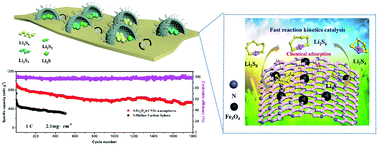Long-life Li–S batteries based on enabling the immobilization and catalytic conversion of polysulfides†
Abstract
Herein, novel hierarchical mesoporous nitrogen-rich carbon nanospheres comprising one-dimensional (1D) bamboo-like carbon nanotubes encapsulating Fe3O4 nanoparticles synthesized through a simple and convenient strategy are used as a high-efficiency host for lithium–sulfur batteries (Li–S batteries). With the large internal cavity, all the nanospheres can effectively ensure high sulfur loading and mitigate the shuttling of the polysulfide. The externally grown bamboo-like carbon nanotubes build up an admirable three-dimensional network for facilitating the rapid transport of ions to improve redox kinetics. Moreover, both experimental and theoretical studies have shown that there is a chemical coupling between the two valence iron ions in Fe3O4 and sulfur for the benefit of the fixation of sulfur, playing a role in catalyzing the conversion of the polysulfide. Combining the above virtues, 2.1 mg cm−2 sulfur loading still retains a high discharge capacity of 538.5 mA h g−1 after 1800 cycles at 1C and the capacity decay is only 0.023% per cycle. With a higher sulfur loading (5.5 mg cm−2), a stable reversible capacity of 739.4 mA h g−1 is also acquired.



 Please wait while we load your content...
Please wait while we load your content...